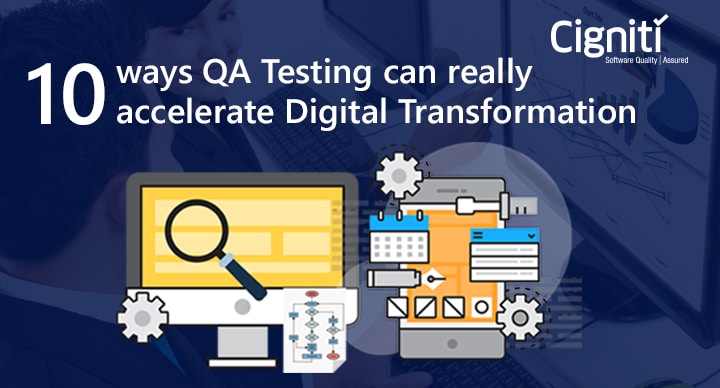Here are your 5 Strong Steps towards Digital Transformation
|
Listen on the go!
|
Strategy, organizational structure, management vision, human resources, and many such factors form the building blocks of an enterprise. If an organization plans to introduce any new strategy or technology, it needs to take a multi-channel perspective and ensure that it is meticulously implemented with everyone’s acceptance. Implementing Digital Transformation services is a decision and a business strategy that can impact every factor within an enterprise. Hence, it is important that you watch out every step on the way. So, how vigilant you must get while starting off with Digital Transformation initiatives?
First and foremost, why is Digital Transformation a strategic decision?
The Gartner 2018 CIO Agenda Industry Insights report shows that all industries rank digital business as one of their top 10 business objectives. Digital Transformation initiatives help organizations to integrate their various business propositions and activities with digital technologies. This helps to not only ensure business value, but deliver excellent customer experience. Nonetheless, enterprises have to go through continuous cultural change to adapt and nurture the value of Digital Transformation.
The report further states that, CIOs from the banking and investment services (26%), telecom (25%) and government (18%) sectors are placing digital business/digital transformation as their number one business objective in 2018. During his session at the Gartner Symposium/ITxpo 2018 in Dubai, Jan-Martin Lowendahl, Research Vice President at Gartner mentioned, “Forty-seven percent of CEOs said they are being challenged by the board of directors to make progress in digital business, and this enterprise- wide focus on digital is also being felt by CIOs across industries”.
Hence, proven that Digital Transformation, though a strategic decision, is a highly sensitive aspect for organizations. There are numerous factors to deal with and manage while adopting and leveraging digital technologies for business and ultimately to make them workable and result-oriented.
Top 5 essential steps for an effective Digital Transformation
While every enterprise and CIO decides his/her own route, there are some ground rules and steps that we feel you must consider for successful Digital Transformation.
1. Clear business objectives will make a good strategy
In order to make the required investments and build the right strategy, it is critical that the business objectives are explicitly discussed and accepted. Digital Technologies can do wonders for your business only if applying them brings relevance for you. Just adopting it for the sake of it can be disastrous and might even bring the required results.
Hence, the first step is to state the business objectives that you intend to achieve by leveraging a particular digital technology. For instance, building a Virtual Reality driven shop site makes absolute sense for a retail or ecommerce player. However, it might not make much sense for an industry that sells B2B industrial tools.
2. Choose the right Technology that brings relevance for Development and Testing
Taking a cue from what was mentioned earlier, investments in terms of technology know-how, tools, skills, and resources is needed to ensure successful digital transformation. It has to be a win-win situation, otherwise, the efforts might not see the light of the day. Hence, it is critical that you choose a technology that your business needs and will guarantee success. Whether it is Internet-of-things (IoT), Artificial Intelligence, Big Data Analysis, or predictive analytics, the technology you choose has to bring business value and empower your goals.
Some businesses might look at immediate results, while some might consider long-term value. Hence, the technology has to be a real fit for you. It will further help you to plan your development and testing requirements, as you would be able to estimate the value that you are expecting from the technology adoption. This would enable you to set your testing and QA objectives as well.
3. Big Data Analysis is important, but action is mandatory
It is recommended that organizations must take informed steps towards digital transformation, which has been made possible due to Big Data Analysis. Moreover, Big Data Testing is critical to ensure that the results are effectively derived and are accurate. Analysis is important, but at the same time, it is important that necessary action is taken with the derived results.
Speed is needed for Digital Transformation initiatives, and most importantly, it is critical to take the necessary risks as well. Testing and Quality Assurance teams can help enterprises to take these risks by effectively testing the technology against the built solutions. Nevertheless, a thorough consumer insight is needed to ensure business success.
4. Focus on Quality Assurance and Testing is inevitable
As we already discussed, Speed is critical to stay competitive and get market share. However, it is equally important to ensure quality of the developed product. For instance, you build a site that gives a virtual tour of your store located across various cities. But it tends to crash during peak shopping hours and during important big day sales. Will you be able to bring value for your customers with such a site?
Hence, ensuring the performance, functionality, security, and accessibility of the application while leveraging digital technologies is very much needed. Your Digital Transformation strategy might have many facets and phases, but QA and Testing has to be at the core. Missing out on it could be disastrous for your business objectives. Organizations leverage tools and QA platforms to ensure that all the quality metrics get tracked scrupulously.
5. Leverage Test Automation, and track your digital objectives
A huge amount of money and efforts are dedicated when a new technology is leveraged, new tools are used, and skilled resources are employed to ensure that success is achieved. Hence, it is important that teams track every step in the development and testing process. It is equally critical to monitor these steps as against the digital objectives that you have stated for Business Transformation.
Test Automation tools and frameworks not only bring down the testing efforts, but ensure accuracy and effective tracking. Automation of tests helps teams to ensure maximum test coverage and ultimately validate different quality factors.
What do you think is most critical for ensuring successful Digital Transformation?
Cigniti’s Digital Assurance solutions address the multifaceted needs of digital testing. We strive to do this by conducting comprehensive testing across your digital value chain and the entire digital ecosystem.
Connect with our Digital QA team to leverage our core digital testing services – Continuous Testing, Omni-Channel Testing, Customer Experience, Cyber Security QA, and Analytics Validation.





Leave a Reply